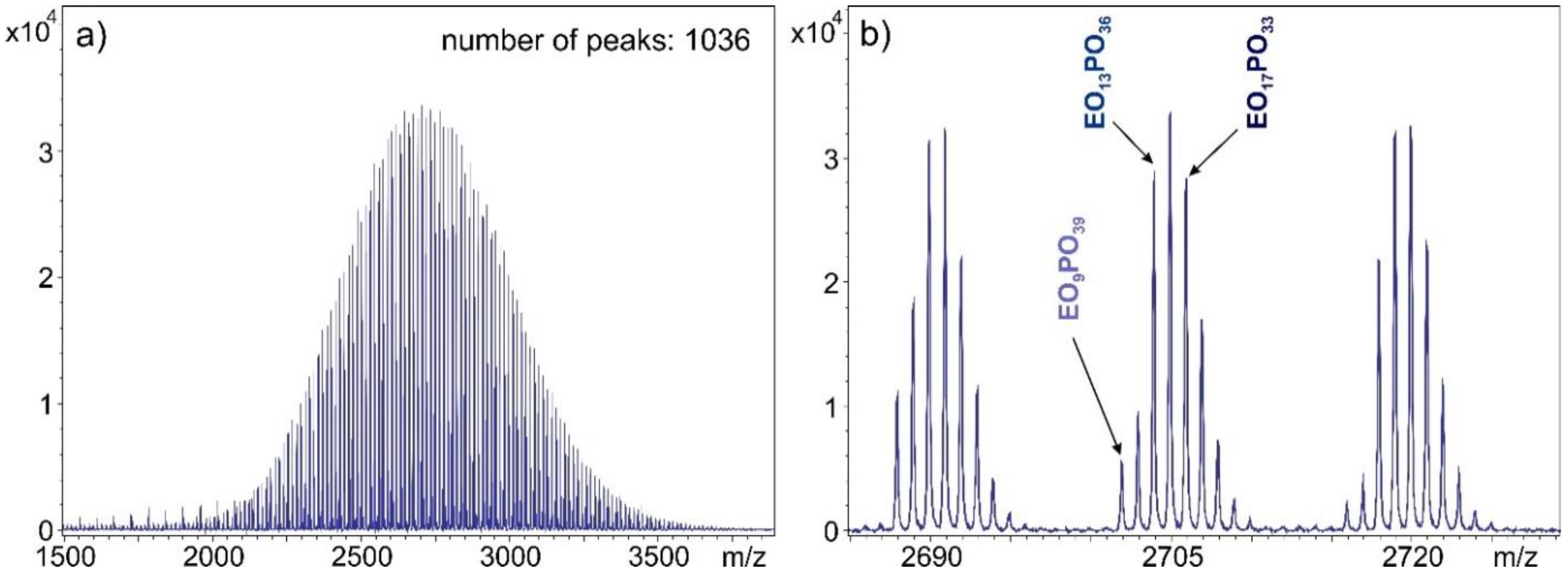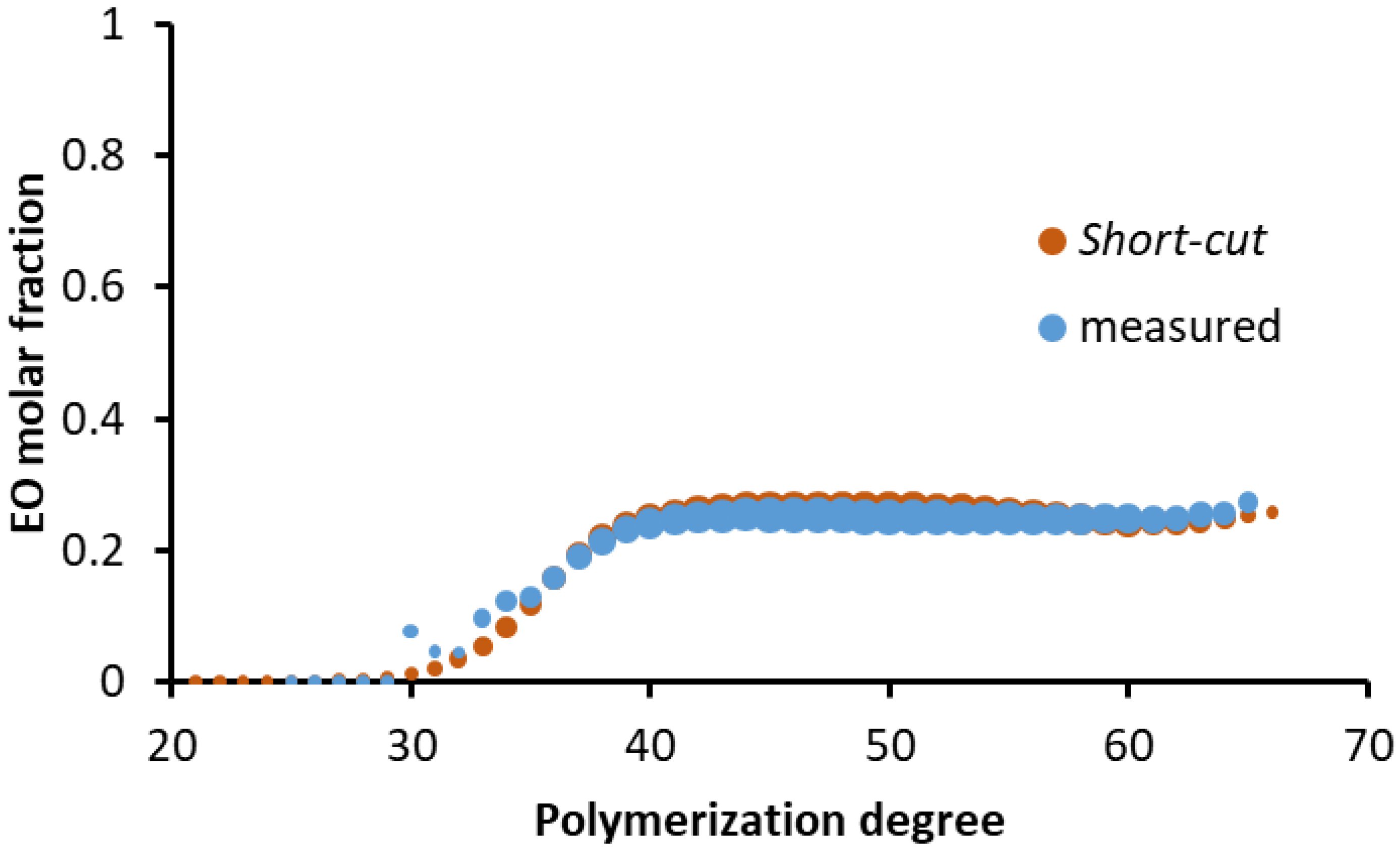A Short-Cut Data Mining Method for the Mass Spectrometric Characterization of Block Copolymers
Abstract
:1. Introduction
2. Experimental
2.1. Chemicals
2.2. Matrix-Assisted Laser Desorption/Ionization Time-of-Flight Mass Spectrometry
3. Results and Discussion
4. Conclusions
Supplementary Materials
Author Contributions
Funding
Institutional Review Board Statement
Informed Consent Statement
Data Availability Statement
Conflicts of Interest
References
- Karas, M.; Hillenkamp, F. Laser desorption ionization of proteins with molecular masses exceeding 10,000 daltons. Anal. Chem. 1988, 60, 2299–2301. [Google Scholar] [CrossRef]
- Tanaka, K.; Waki, H.; Ido, Y.; Akita, S.; Yoshida, Y.; Yoshida, T.; Matsuo, T. Protein and polymer analyses up to m/z 100 000 by laser ionization time-of-flight mass spectrometry. Rapid Commun. Mass Spectrom. 1988, 2, 151–153. [Google Scholar] [CrossRef]
- Wong, S.F.; Meng, C.K.; Fenn, J.B. Multiple charging in electrospray ionization of poly(ethylene glycols). J. Phys. Chem. 1988, 92, 546–550. [Google Scholar] [CrossRef]
- Weidner, S.M.; Falkenhagen, J.; Bressler, I. Copolymer Composition Determined by LC-MALDI-TOF MS Coupling and “MassChrom2D” Data Analysis. Macromol. Chem. Phys. 2012, 213, 2404–2411. [Google Scholar] [CrossRef]
- Pasch, H. Hyphenated separation techniques for complex polymers. Polym. Chem. 2013, 4, 2628–2650. [Google Scholar] [CrossRef]
- Crotty, S.; Gerişlioğlu, S.; Endres, K.J.; Wesdemiotis, C.; Schubert, U.S. Polymer architectures via mass spectrometry and hyphenated techniques: A review. Anal. Chim. Acta 2016, 932, 1–21. [Google Scholar] [CrossRef] [Green Version]
- Wesdemiotis, C. Multidimensional Mass Spectrometry of Synthetic Polymers and Advanced Materials. Angew. Chem. Int. Ed. 2017, 56, 1452–1464. [Google Scholar] [CrossRef] [Green Version]
- Róth, G.; Nagy, T.; Kuki, Á.; Hashimov, M.; Vonza, Z.; Timári, I.; Zsuga, M.; Kéki, S. Polydispersity Ratio and Its Application for the Characterization of Poloxamers. Macromolecules 2021, 54, 9984–9991. [Google Scholar] [CrossRef]
- Fouquet, T.; Sato, H. Extension of the Kendrick Mass Defect Analysis of Homopolymers to Low Resolution and High Mass Range Mass Spectra Using Fractional Base Units. Anal. Chem. 2017, 89, 2682–2686. [Google Scholar] [CrossRef] [Green Version]
- Fouquet, T.N.J. The Kendrick analysis for polymer mass spectrometry. J. Mass Spectrom. 2019, 54, 933–947. [Google Scholar] [CrossRef]
- Suen, W.; Percy, J.; Hsu, S.L.; Kaltashov, I.A.; Stidham, H.D. Influence of Polyether Copolymer Configuration on Polyurethane Reaction: A Mass Spectrometry Analysis. Cell. Polym. 2003, 22, 23–42. [Google Scholar] [CrossRef]
- Terrier, P.; Buchmann, W.; Cheguillaume, G.; Desmazières, B.; Tortajada, J. Analysis of Poly(oxyethylene) and Poly(oxypropylene) Triblock Copolymers by MALDI-TOF Mass Spectrometry. Anal. Chem. 2005, 77, 3292–3300. [Google Scholar] [CrossRef] [PubMed]
- Engler, M.S.; Crotty, S.; Barthel, M.J.; Pietsch, C.; Knop, K.; Schubert, U.S.; Böcker, S. COCONUT—An Efficient Tool for Estimating Copolymer Compositions from Mass Spectra. Anal. Chem. 2015, 87, 5223–5231. [Google Scholar] [CrossRef]
- Montaudo, M.S.; Adamus, G.; Kowalczuk, M. Bivariate distribution in copolymers: A new model. J. Polym. Sci. Part A Polym. Chem. 2002, 40, 2442–2448. [Google Scholar] [CrossRef]
- Nagy, T.; Kuki, Á.; Zsuga, M.; Kéki, S. Mass-Remainder Analysis (MARA): A New Data Mining Tool for Copolymer Characterization. Anal. Chem. 2018, 90, 3892–3897. [Google Scholar] [CrossRef] [PubMed]
- Kuki, Á.; Nagy, T.; Hashimov, M.; File, S.; Nagy, M.; Zsuga, M.; Kéki, S. Mass Spectrometric Characterization of Epoxidized Vegetable Oils. Polymers 2019, 11, 394. [Google Scholar] [CrossRef] [Green Version]
- Nagy, T.; Kuki, Á.; Nagy, M.; Zsuga, M.; Kéki, S. Mass-Remainder Analysis (MARA): An Improved Method for Elemental Composition Assignment in Petroleomics. Anal. Chem. 2019, 91, 6479–6486. [Google Scholar] [CrossRef] [PubMed]
- Nagy, T.; Kuki, Á.; Hashimov, M.; Zsuga, M.; Kéki, S. Multistep Mass-Remainder Analysis and its Application in Copolymer Blends. Macromolecules 2020, 53, 1199–1204. [Google Scholar] [CrossRef]
- Nagy, T.; Róth, G.; Kuki, Á.; Zsuga, M.; Kéki, S. Mass Spectral Filtering by Mass-Remainder Analysis (MARA) at High Resolution and Its Application to Metabolite Profiling of Flavonoids. Int. J. Mol. Sci. 2021, 22, 864. [Google Scholar] [CrossRef]
- Liu, T.; Wu, C.; Xie, Y.; Liang, D.; Zhou, S.; Nace, V.M.; Chu, B. Amphiphilic polyoxyalkylene triblock copolymers: Self-assembly, phase behaviors, and new applications. In Associative Polymers in Aqueous Media; American Chemical Society: Washington, DC, USA, 2000; Volume 765, pp. 2–20. [Google Scholar]
- Yokoyama, M. Block copolymers as drug carriers. Crit. Rev. Ther. Drug Carrier Syst. 1992, 9, 213–248. [Google Scholar]
- Edens, M.W. Applications of polyoxyalkylene block copolymer surfactants. In Nonionic Surfactants Polyoxyalkylene Block Copolymers; Nace, V., Ed.; Taylor & Francis: Abingdon-on-Thames, UK, 1996; p. 26. [Google Scholar]
- Van Rooij, G.J.; Duursma, M.C.; de Koster, C.G.; Heeren, R.M.A.; Boon, J.J.; Schuyl, P.J.W.; van der Hage, E.R.E. Determination of Block Length Distributions of Poly(oxypropylene) and Poly(oxyethylene) Block Copolymers by MALDI-FTICR Mass Spectrometry. Anal. Chem. 1998, 70, 843–850. [Google Scholar] [CrossRef]




| Name | EO Weight Fraction (m/m %) | Blocks |
|---|---|---|
| RPE 2520 | 20 | PPO-PEO-PPO |
| RPE 1720-1 | 20 | PPO-PEO-PPO |
| PE 6100-1 | 10 | PEO-PPO-PEO |
| PE 6100-2 | 10 | PEO-PPO-PEO |
| RPE 1720-2 | 20 | PPO-PEO-PPO |
| PE 6200 | 20 | PEO-PPO-PEO |
| RPE 1740 | 40 | PPO-PEO-PPO |
| RPE3110 | 10 | PPO-PEO-PPO |
| Name | Process Method | Mn | Mw | Đ | cEO | wEO | nnEO | nwEO | ĐEO | nnPO | nwPO | ĐPO |
|---|---|---|---|---|---|---|---|---|---|---|---|---|
| RPE2520 | reference | 2727 | 2758 | 1.011 | 0.256 | 0.207 | 12.6 | 13.2 | 1.05 | 36.7 | 37.2 | 1.01 |
| short cut | 2678 | 2694 | 1.006 | 0.259 | 0.210 | 12.7 | 13.3 | 1.04 | 36.6 | 37.1 | 1.01 | |
| RPE1720 | reference | 2102 | 2142 | 1.019 | 0.299 | 0.241 | 11.4 | 12.2 | 1.06 | 26.8 | 27.5 | 1.03 |
| short cut | 2082 | 2102 | 1.010 | 0.299 | 0.245 | 11.7 | 12.4 | 1.06 | 26.7 | 27.4 | 1.03 | |
| PE6100 | reference | 1801 | 1863 | 1.034 | 0.072 | 0.055 | 2.2 | 4.7 | 2.14 | 28.6 | 29.5 | 1.03 |
| short cut | 1623 | 1675 | 1.032 | 0.071 | 0.056 | 2.4 | 4.6 | 1.93 | 27.3 | 28.3 | 1.04 | |
| PE6100 | reference | 1930 | 1975 | 1.023 | 0.091 | 0.071 | 3.0 | 5.4 | 1.78 | 30.2 | 30.9 | 1.02 |
| short cut | 1763 | 1799 | 1.020 | 0.091 | 0.071 | 3.2 | 5.4 | 1.70 | 29.6 | 30.6 | 1.03 | |
| RPE1720 | reference | 2291 | 2324 | 1.015 | 0.300 | 0.245 | 12.5 | 13.3 | 1.06 | 29.2 | 29.7 | 1.02 |
| short cut | 2259 | 2274 | 1.007 | 0.302 | 0.248 | 12.8 | 13.4 | 1.05 | 29.2 | 29.9 | 1.02 | |
| PE6200 | reference | 2528 | 2577 | 1.019 | 0.369 | 0.307 | 17.4 | 19.8 | 1.14 | 29.7 | 30.2 | 1.02 |
| short cut | 2431 | 2458 | 1.011 | 0.369 | 0.309 | 17.2 | 19.3 | 1.12 | 29.6 | 30.0 | 1.02 | |
| RPE1740 | reference | 2445 | 2468 | 1.009 | 0.510 | 0.441 | 24.1 | 24.5 | 1.02 | 23.1 | 23.6 | 1.02 |
| short cut | 2389 | 2401 | 1.005 | 0.509 | 0.441 | 24.1 | 24.6 | 1.02 | 22.8 | 23.3 | 1.02 | |
| RPE3110 | reference | 3440 | 3471 | 1.009 | 0.210 | 0.168 | 12.9 | 13.7 | 1.06 | 48.7 | 49.3 | 1.01 |
| short cut | 3402 | 3422 | 1.006 | 0.209 | 0.167 | 12.8 | 13.4 | 1.05 | 48.5 | 49.0 | 1.01 |
Publisher’s Note: MDPI stays neutral with regard to jurisdictional claims in published maps and institutional affiliations. |
© 2021 by the authors. Licensee MDPI, Basel, Switzerland. This article is an open access article distributed under the terms and conditions of the Creative Commons Attribution (CC BY) license (https://creativecommons.org/licenses/by/4.0/).
Share and Cite
Kuki, Á.; Róth, G.; Nagy, A.; Zsuga, M.; Kéki, S.; Nagy, T. A Short-Cut Data Mining Method for the Mass Spectrometric Characterization of Block Copolymers. Processes 2022, 10, 42. https://doi.org/10.3390/pr10010042
Kuki Á, Róth G, Nagy A, Zsuga M, Kéki S, Nagy T. A Short-Cut Data Mining Method for the Mass Spectrometric Characterization of Block Copolymers. Processes. 2022; 10(1):42. https://doi.org/10.3390/pr10010042
Chicago/Turabian StyleKuki, Ákos, Gergő Róth, Anna Nagy, Miklós Zsuga, Sándor Kéki, and Tibor Nagy. 2022. "A Short-Cut Data Mining Method for the Mass Spectrometric Characterization of Block Copolymers" Processes 10, no. 1: 42. https://doi.org/10.3390/pr10010042
APA StyleKuki, Á., Róth, G., Nagy, A., Zsuga, M., Kéki, S., & Nagy, T. (2022). A Short-Cut Data Mining Method for the Mass Spectrometric Characterization of Block Copolymers. Processes, 10(1), 42. https://doi.org/10.3390/pr10010042










